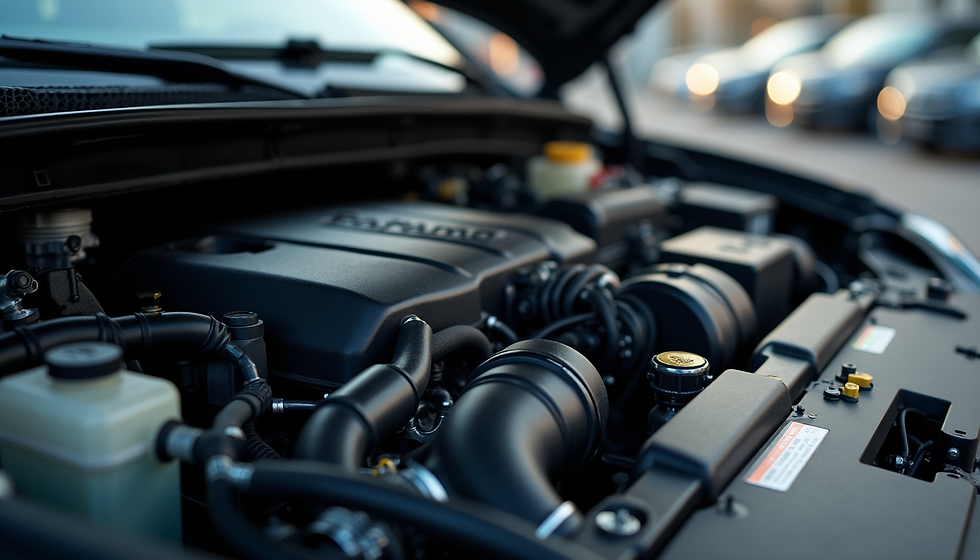♻️ Engine Exhaust System Tuning – Optimize Emissions Control and Performance
- massimocuguttu
- Aug 7
- 3 min read
Updated: Aug 26
Modern engines are equipped with multiple systems to reduce harmful emissions such as CO (carbon monoxide), NOx (nitrogen oxides), HC (unburned hydrocarbons), and PM (particulate matter). These pollutants are the result of non-ideal combustion, especially under real-world driving conditions.
While CO₂ is an unavoidable byproduct of combustion and can only be reduced by lowering fuel consumption (and thus power), other pollutants are managed through dedicated aftertreatment devices — often at the cost of engine performance, fuel efficiency, and mechanical durability.
Let’s take a closer look at how these systems work, their impact on the vehicle, and how ECU tuning can help.
🔬 Common Exhaust Pollutants and Their Treatment Systems
Pollutant | Source | Aftertreatment System |
NOx (Nitrogen Oxides) | High combustion temperatures | EGR, SCR |
CO (Carbon Monoxide) | Incomplete combustion | Three-Way Catalyst |
HC (Hydrocarbons) | Unburned fuel | Three-Way Catalyst |
PM (Particulate Matter) | Soot particles from diesel/gasoline engines | DPF, GPF |
🧪 How These Systems Work – Pros & Cons
1. EGR (Exhaust Gas Recirculation)
Mechanism: Redirects a portion of exhaust gas back into the intake to lower combustion temperatures and reduce NOx.
Pros:
Reduces NOx at source.
No need for additional chemical fluids.
Cons:
Increases soot buildup → clogging and wear.
Reduces combustion efficiency → more fuel burned.
Contributes to oil contamination and intake manifold fouling.
🔧 EGR can be safely disabled via ECU tuning. It does not require hardware removal and is often not detected during vehicle inspections.
2. SCR (Selective Catalytic Reduction)
Mechanism: Injects AdBlue (urea solution) into the exhaust to chemically convert NOx into nitrogen and water.
Pros:
Highly effective at NOx reduction.
Needed to meet Euro 6+ standards.
Cons:
Requires AdBlue fluid maintenance.
Complex system prone to faults (pumps, injectors, sensors).
Can trigger derating or limp modes if malfunctioning.
🔧 SCR removal is possible through tuning and hardware deactivation but will cause the vehicle to fail emission checks.
3. Catalytic Converter
Mechanism: Oxidizes CO and HC into CO₂ and H₂O through a precious-metal-based catalyst.
Pros:
Passive operation.
No fluid required.
Cons:
Sensitive to fuel quality.
Degrades over time, especially with rich fuel mixtures or misfires.
Increases backpressure, slightly reducing power.
🔧 Catalyst tuning is usually not recommended unless damaged. It plays a central role in Euro 4/5/6 compliance.
4. DPF/GPF (Diesel/Gasoline Particulate Filter)
Mechanism: Physically traps soot and burns it off during regeneration cycles.
Pros:
Effective at reducing fine particle emissions.
Cons:
Frequent clogging in city or short trips.
Increases backpressure → reduced performance.
Regeneration failures can lead to costly replacements.
🔧 DPF/GPF can be removed through tuning and hardware deactivation, but must be done with awareness of legal and inspection implications. In many cases, a forced regeneration or diagnosis may solve the issue without needing replacement.
🧠 ECU Tuning for Exhaust System Optimization
Through professional ECU reprogramming, we can:
Disable faulty EGR valves without any hardware modification
Delete DPF/SCR systems after physical removal or modification in the devices or related sensors
Remove fault codes (DTCs) related to the aftertreatment
Improve fuel efficiency and engine response by reducing parasitic loads
This kind of tuning is especially useful for:
Vehicles used in off-road or motorsport applications
Engines with persistent DPF or SCR issues
Owners looking to avoid expensive part replacements (e.g. SCR tanks, DPFs, sensors)
⚠️ Important Notice – Legal and Technical Awareness
While it is technically possible to remove DPF and SCR systems, you must be aware of the consequences:
❌ Your vehicle may fail official emissions inspections
🚨 Modified systems may violate local environmental laws
✅ EGR removal, on the other hand, is commonly undetected and reversible
Before proceeding with any modification, we always recommend:
A full diagnostic scan of the engine
Manual regeneration attempts
Consulting us for the most cost-effective and compliant solution
🔍 Custom Solutions – Case-by-Case Analysis
Every vehicle, use case, and owner has different priorities. That’s why we analyze each situation individually, evaluating:
The engine’s health
The type and location of fault
The best balance between performance, reliability, and cost
The implications for road legality
All interventions come with a service guarantee, and we’re always transparent about what is legally safe — and what’s not.
📞 Get in Touch
If you're facing issues with your exhaust system or considering a performance upgrade, Contact Us. We’ll help you decide if tuning or repair is the best option — and provide you with a professional, reliable, and transparent solution.



Comments